Removal of Sr(II) in Aqueous Solutions Using Magnetic Crayfish Shell Biochar
Abstract
1. Introduction
2. Experimental Section
2.1. Materials
2.2. mag@CSBC
2.3. Characterization
2.4. Adsorption Experiments
2.4.1. Adsorption Isotherms and Kinetics
2.4.2. Effect of Dosage, pH, Temperature and Na(I)
2.4.3. Adsorption-Desorption Experiment
3. Results and Discussion
3.1. Characterization
3.1.1. SEM Observation
3.1.2. XRD Patterns
3.1.3. FTIR Spectra
3.1.4. VSM Analyses
3.2. Adsorption Experiment
3.2.1. Adsorption Isotherms
3.2.2. Adsorption Kinetics
3.2.3. Effect of Dosage
3.2.4. Effect of pH
3.2.5. Effect of Temperature
3.2.6. Effects of Na(I)
3.2.7. Adsorption–Desorption
3.3. Mechanism
4. Conclusions
Author Contributions
Funding
Institutional Review Board Statement
Informed Consent Statement
Data Availability Statement
Conflicts of Interest
References
- Nitzsche, K.N.; Wakaki, S.; Yamashita, K.; Shin, K.; Kato, Y.; Kamauchi, H.; Tayasu, I. Calcium and strontium stable isotopes reveal similar behaviors of essential Ca and nonessential Sr in stream food webs. Ecosphere 2022, 13, e3921. [Google Scholar] [CrossRef]
- Xing, M.; Jiang, Y.; Bi, W.; Gao, L.; Zhou, Y.-L.; Rao, S.-L.; Ma, L.-L.; Zhang, Z.-W.; Yang, H.-T.; Chang, J. Strontium ions protect hearts against myocardial ischemia/reperfusion injury. Sci. Adv. 2021, 7, eabe0726. [Google Scholar] [CrossRef]
- Hu, B.; Qiu, M.; Hu, Q.; Sun, Y.; Sheng, G.; Hu, J.; Ma, J. Decontamination of Sr(II) on Magnetic Polyaniline/Graphene Oxide Composites: Evidence from Experimental, Spectroscopic, and Modeling Investigation. ACS Sustain. Chem. Eng. 2017, 5, 6924–6931. [Google Scholar] [CrossRef]
- Lalhmunsiama; Tiwari, D.; Lee, S.-M. Physico-chemical studies in the removal of Sr(II) from aqueous solutions using activated sericite. J. Environ. Radioact. 2015, 147, 76–84. [Google Scholar] [CrossRef]
- Boyer, A.; Ning, P.; Killey, D.; Klukas, M.; Rowan, D.; Simpson, A.J.; Passeport, E. Strontium adsorption and desorption in wetlands: Role of organic matter functional groups and environmental implications. Water Res. 2018, 133, 27–36. [Google Scholar] [CrossRef] [PubMed]
- Höllriegl, V.; München, H.Z. Strontium in the environment and possible human health effects. Encycl. Environ. Health 2011, 5, 268–275. [Google Scholar]
- Martín-Torrijos, L.; Martínez-Ríos, M.; Casabella-Herrero, G.; Adams, S.B.; Jackson, C.R.; Diéguez-Uribeondo, J. Tracing the origin of the crayfish plague pathogen, Aphanomyces astaci, to the Southeastern United States. Sci. Rep. 2021, 11, 9332. [Google Scholar] [CrossRef] [PubMed]
- Tang, C.; Xu, Y.; Yu, D.; Xia, W. Label-free quantification proteomics reveals potential proteins associated with the freshness status of crayfish (Procambarus clarkii) as affected by cooking. Food Res. Int. 2022, 160, 111717. [Google Scholar] [CrossRef]
- He, C.; Lin, H.; Dai, L.; Qiu, R.; Tang, Y.; Wang, Y.; Duan, P.-G.; Ok, Y.S. Waste shrimp shell-derived hydrochar as an emergent material for methyl orange removal in aqueous solutions. Environ. Int. 2019, 134–143, 105340. [Google Scholar] [CrossRef]
- Bloomer, C.C.; Taylor, C.A.; Distefano, R.J. Integrating burrowing crayfish and waterfowl conservation management on moist-soil wetlands. Environ. Conserv. 2022, 49, 130–135. [Google Scholar] [CrossRef]
- Khan, I.; Saeed, K.; Khan, I.J. Nanoparticles: Properties, applications and toxicities. Arab. J. Chem. 2019, 12, 908–931. [Google Scholar] [CrossRef]
- Lehmann, J.; Kleber, M. The contentious nature of soil organic matter. Nature 2015, 528, 60–68. [Google Scholar] [CrossRef] [PubMed]
- Li, H.; Dong, X.; da Silva, E.B.; de Oliveira, L.M.; Chen, Y.; Ma, L.Q. Mechanisms of metal sorption by biochars: Biochar characteristics and modifications. Chemosphere 2017, 178, 466–478. [Google Scholar] [CrossRef] [PubMed]
- Nansubuga, I.; Banadda, N.; Ronsse, F.; Verstraete, W.; Rabaey, K. Digestion of high rate activated sludge coupled to biochar formation for soil improvement in the tropics. Water Res. 2015, 81, 216–222. [Google Scholar] [CrossRef]
- Woolf, D.; Lehmann, J.; Lee, D.R. Optimal bioenergy power generation for climate change mitigation with or without carbon sequestration. Nat. Commun. 2016, 7, 13160. [Google Scholar] [CrossRef] [PubMed]
- Gao, R.; Xiang, L.; Hu, H.; Fu, Q.; Zhu, J.; Liu, Y.; Huang, G. High effificiency removal capacities and quantitative sorption mechanisms of Pb by oxidized rape straw biochars. Sci. Total Environ. 2020, 699, 134–262. [Google Scholar] [CrossRef]
- Zhang, M.; Shu, L.; Shen, X.; Guo, X.; Tao, S.; Xing, B.; Wang, X. Characterization of nitrogen-rich biomaterial-derived biochars and their sorption for aromatic compounds. Environ. Pollut. 2014, 195, 84–90. [Google Scholar] [CrossRef]
- Zeng, Y.F.; Xue, Y.W.; Long, L.; Yan, J.P. Novel crayfish shell biochar nanocomposites loaded with Ag-TiO2 nanoparticles exhibit robust antibacterial activity. Water Air Soil Pollut. 2019, 230, 9–15. [Google Scholar] [CrossRef]
- Tran, H.N. Comments on “Characterization and adsorption capacity of raw pomegranate peel biosorbent for copper removal”. J. Clean. Prod. 2017, 144, 553–558. [Google Scholar] [CrossRef]
- Attallah, M.F.; Rizk, S.E.; Shady, S.A. Separation of ~(152 + 154)Eu,~(90)Sr from radioactive waste effluent using liquid–liquid extraction by polyglycerol phthalate. Nucl. Sci. Tech. 2018, 29, 84. [Google Scholar] [CrossRef]
- Liu, Y.; Chen, R.; Yuan, D.; Liu, Z.; Meng, M.; Wang, Y.; Han, J.; Meng, X.; Liu, F.; Hu, Z.; et al. Thermal-responsive ion-imprinted polymer based on magnetic mesoporous silica SBA-15 for selective removal of Sr(II) from aqueous solution. Colloid Polym. Sci. 2014, 293, 109–123. [Google Scholar] [CrossRef]
- Zhang, N.; Liu, S.; Jiang, L.; Luo, M.; Chi, C.; Ma, J. Adsorption of strontium from aqueous solution by silica mesoporous SBA-15. J. Radioanal. Nucl. Chem. 2014, 303, 1671–1677. [Google Scholar] [CrossRef]
- Youssef, M.A.; Rizk, H.E.; Attallah, M.F. Purification of liquid scintillation waste from binding radionuclides using different adsorbents. Radiochim. Acta 2020, 108, 879–887. [Google Scholar] [CrossRef]
- Kaveeshwar, A.R.; Kumar, P.S.; Revellame, E.D.; Gang, D.D.; Zappi, M.E.; Subramaniam, R. Adsorption properties and mechanism of barium (II) and strontium (II) removal from fracking wastewater using pecan shell based activated carbon. J. Clean. Prod. 2018, 193, 1–13. [Google Scholar] [CrossRef]
- Jang, J.; Miran, W.; Divine, S.D.; Nawaz, M.; Shahzad, A.; Woo, S.H.; Lee, D.S. Rice straw-based biochar beads for the removal of radioactive strontium from aqueous solution. Sci. Total Environ. 2017, 615, 698–707. [Google Scholar] [CrossRef]
- Choi, J.-W.; Cho, S.; Choi, S.-J. Ecofriendly, selective removal of radioactive strontium ions in aqueous solutions using magnetic banana peels. Sci. Total Environ. 2021, 778, 146327. [Google Scholar] [CrossRef]
- Uematsu, Y.; Ogata, F.; Saenjum, C.; Nakamura, T.; Kawasaki, N. Removing Sr(II) and Cs(I) from the Aqueous Phase Using Basil Seed and Elucidating the Adsorption Mechanism. Sustainability 2020, 12, 2895. [Google Scholar] [CrossRef]
- Imessaoudene, D.; Hanini, S.; Bouzidi, A. Biosorption of strontium from aqueous solutions onto spent coffee grounds. J. Radioanal. Nucl. Chem. 2013, 298, 893–902. [Google Scholar] [CrossRef]
- Wang, F.Y.; Wang, H.; Ma, J.W. Adsorption of cadmium(II) ions from aqueous solution by a new low-cost adsorbent-bamboo charcoal. J. Hazard. Mater. 2010, 177, 300–306. [Google Scholar] [CrossRef] [PubMed]
- Pérez-Calixto, M.; Ortega, A.; Garcia-Uriostegui, L.; Burillo, G. Synthesis and characterization of N-vinylcaprolactam/N,N-dimethylacrylamide grafted onto chitosan networks by gamma radiation. Radiat. Phys. Chem. 2016, 119, 228–235. [Google Scholar] [CrossRef]
- Nasef, S.M.; Khozemy, E.E.; Kamoun, E.A.; El-gendi, H. Gamma Radiation-Induced Crosslinked Composite Membranes Based on Polyvinyl Alcohol/Chitosan/AgNO3/Vitamin E for Biomedical Applications. Int. J. Biol. Macromol. 2019, 137, 878–885. [Google Scholar] [CrossRef]
- Swantomo, D.; Basuki, K.T.; Synthesis, S.R. Characterization of Graft Copolymer Rice Straw Cellulose-Acrylamide. Atom Indones. 2013, 39, 57–64. [Google Scholar] [CrossRef]
- Qiu, L.; Feng, J.; Dai, Y.; Chang, S. Biosorption of strontium ions from simulated high-level liquid waste by living Saccharomyces cerevisiae. Environ. Sci. Pollut. Res. 2018, 25, 17194–17206. [Google Scholar] [CrossRef]
- Wang, T.; Zheng, X.; Wang, X.; Lu, X.; Shen, Y. Different biosorption mechanisms of Uranium(VI) by live and heat-killed Saccharomyces cerevisiae under environmentally relevant conditions. J. Environ. Radioact. 2017, 167, 92–99. [Google Scholar] [CrossRef] [PubMed]
- Zhang, X.; Zhang, P.; Yuan, X.; Li, Y.; Han, L. Effect of pyrolysis temperature and correlation analysis on the yield and physicochemical properties of crop residue biochar. Bioresour. Technol. 2019, 296, 122318. [Google Scholar] [CrossRef]
- Lee, X.J.; Lee, L.Y.; Hiew, B.Y.Z.; Gan, S.; Thangalazhy Gopakumar, S.; Kiat Ng, H. Multistage optimizations of slow pyrolysis synthesis of biochar from palm oil sludge for adsorption of lead. Bioresour. Technol. 2017, 245, 944–953. [Google Scholar] [CrossRef]
- Zu, Z. Cationic dyes removal using low-cost banana peel biosorbent. Am. J. Sci. 2018, 8, 32–38. [Google Scholar]
- Mondal, S.; Majumder, S.K. Honeycomb-like porous activated carbon for efficient copper (II) adsorption synthesized from natural source: Kinetic study and equilibrium isotherm analysis. J. Environ. Chem. Eng. 2019, 7, 103236. [Google Scholar] [CrossRef]
- Kearns, J.; Wellborn, L.; Summers, R.; Knappe, D. 2,4-D adsorption to biochars: Effect of preparation conditions on equilibrium adsorption capacity and comparison with commercial activated carbon literature data. Water Res. 2014, 62, 20–28. [Google Scholar] [CrossRef]
- Zhao, L.; Cao, X.; Mašek, O.; Zimmerman, A. Heterogeneity of biochar properties as a function of feedstock sources and production temperatures. J. Hazard. Mater. 2013, 256–257, 1–9. [Google Scholar] [CrossRef] [PubMed]
- Zhao, B.; O’Connor, D.; Zhang, J.; Peng, T.; Shen, Z.; Tsang, D.C.W.; Hou, D. Effect of pyrolysis temperature, heating rate, and residence time on rapeseed stem derived biochar. J. Clean. Prod. 2018, 174, 977–987. [Google Scholar] [CrossRef]
- Chen, Y.; Yang, H.; Wang, X.; Zhang, S.; Chen, H. Biomass-based pyrolytic polygeneration system on cotton stalk pyrolysis: Influence of temperature. Bioresour. Technol. 2012, 107, 411–418. [Google Scholar] [CrossRef] [PubMed]
- Sigmund, G.; Hüffer, T.; Hofmann, T.; Kah, M. Biochar total surface area and total pore volume determined by N2 and CO2 physisorption are strongly influenced by degassing temperature. Sci. Total Environ. 2017, 580, 770–775. [Google Scholar] [CrossRef] [PubMed]
- Wang, S.; Bian, S.; Liu, J.; Li, J.; Xu, S.; Liang, Z. Highly adsorptive pristine and magnetic biochars prepared from crayfish shell for removal of Cu(II) and Pb(II). J. Taiwan Inst. Chem. Eng. 2021, 127, 175–185. [Google Scholar] [CrossRef]
- Sun, T.; Xu, Y.; Sun, Y.; Wang, L.; Liang, X.; Jia, H. Crayfish shell biochar for the mitigation of Pb contaminated water and soil: Characteristics, mechanisms, and applications. Environ. Pollut. 2020, 271, 116308. [Google Scholar] [CrossRef]
- Deshmukh, P.D.; Khadse, G.K.; Shinde, V.M.; Labhasetwar, P. Cadmium Removal from Aqueous Solutions Using Dried Banana Peels as An Adsorbent: Kinetics and Equilibrium Modeling. J. Bioremediation Biodegrad. 2017, 8, 1000395. [Google Scholar] [CrossRef]
- Lu, H.; Zhang, W.; Yang, Y.; Huang, X.; Wang, S.; Qiu, R. Relative distribution of Pb2+ sorption mechanisms by sludge-derived biochar. Water Res. 2012, 46, 854–862. [Google Scholar] [CrossRef]
- Cao, X.; Harris, W. Properties of dairy-manure-derived biochar pertinent to its potential use in remediation. Bioresour. Technol. 2010, 101, 5222–5228. [Google Scholar] [CrossRef]
- Xia, Y.; Yang, T.; Zhu, N.; Li, D.; Chen, Z.; Lang, Q.; Liu, Z.; Jiao, W. Enhanced adsorption of Pb(II) onto modified hydrochar: Modeling and mechanism analysis. Bioresour. Technol. 2019, 288, 121593. [Google Scholar] [CrossRef]
- Chia, C.H.; Gong, B.; Joseph, S.D.; Marjo, C.E.; Munroe, P.; Rich, A.M. Imaging of mineral enriched biochar by FTIR, Raman and SEM-EDX. Vib. Spectrosc. 2012, 62, 248–257. [Google Scholar] [CrossRef]
- Zhou, L.; Ji, L.; Ma, P.-C.; Shao, Y.; Zhang, H.; Gao, W.; Li, Y. Development of carbon nanotubes/CoFe2O4 magnetic hybrid material for removal of tetrabromobisphenol A and Pb(II). J. Hazard. Mater. 2014, 265, 104–114. [Google Scholar] [CrossRef]
- Lee, H.-K.; Lee, H.-J.; Choi, J.-W.; Oh, W.; Choi, S.-J. Selective removal of cesium ions from aqueous solutions by zinc hexacyanoferrate functionalized magnetic carbon nanotube composites as adsorbent. J. Radioanal. Nucl. Chem. 2017, 314, 2357–2363. [Google Scholar] [CrossRef]
- Koilraj, P.; Kamura, Y.; Sasaki, K. Synergetic co-immobilization of SeO42− and Sr2+ from aqueous solution onto multifunctional graphene oxide and carbon-dot based layered double hydroxide nanocomposites and their mechanistic investigation. J. Mater. Chem. A 2018, 6, 10008–10018. [Google Scholar] [CrossRef]
- Thirumavalavan, M.; Lai, Y.-L.; Lee, J.-F. Fourier Transform Infrared Spectroscopic Analysis of Fruit Peels before and after the Adsorption of Heavy Metal Ions from Aqueous Solution. J. Chem. Eng. Data 2011, 56, 2249–2255. [Google Scholar] [CrossRef]
- Liu, M.; Chen, C.; Hu, J.; Wu, X.; Wang, X. Synthesis of Magnetite/Graphene Oxide Composite and Application for Cobalt(II) Removal. J. Phys. Chem. C 2011, 115, 25234–25240. [Google Scholar] [CrossRef]
- Ding, D.; Lei, Z.; Yang, Y.; Feng, C.; Zhang, Z. Selective removal of cesium from aqueous solutions with nickel (II) hexacyanoferrate (III) functionalized agricultural residue–walnut shell. J. Hazard. Mater. 2014, 14, 2251–2276. [Google Scholar] [CrossRef] [PubMed]
- Wang, J.; Guo, X. Adsorption isotherm models: Classification, physical meaning, application and solving method. Chemosphere 2020, 258, 127–134. [Google Scholar] [CrossRef] [PubMed]
- Zhuravlev, I. Titanium Silicates Precipitated on the Rice Husk Biochar as Adsorbents for the Extraction of Cesium and Strontium Radioisotope Ions. Colloids Interfaces 2019, 3, 36. [Google Scholar] [CrossRef]
- Saleh, A.S.; Ibrahim, A.G.; Elsharma, E.M.; Metwally, E.; Siyam, T. Radiation grafting of acrylamide and maleic acid on chitosan and effective application for removal of Co(II) from aqueous solutions. Radiat. Phys. Chem. 2018, 144, 116–124. [Google Scholar] [CrossRef]
- Basuki, K.T.; Swantomo, D.; Sigit; Megasari, K. Effect of Deacetylation on Characterization of pH Stimulus Responsive Chitosan-Acrylamide Hydrogels Using Radiation. Adv. Mater. Res. 2014, 896, 292–295. [Google Scholar] [CrossRef]
- Wang, Y.; Long, J.; Xu, W.; Luo, H.; Liu, J.; Zhang, Y.; Li, J.; Luo, X. Removal of uranium (VI) from simulated wastewater by a novel porous membrane based on crosslinked chitosan, UiO-66-NH 2 and polyvinyl alcohol. J. Radioanal. Nucl. Chem. 2021, 173, 1142–1159. [Google Scholar]
- Mei, J.; Mo, S.; Zhang, H.; Zheng, X.; Li, Z. Removal of Sr(II) from water with highly-elastic carboxymethyl chitosan gel. Int. J. Biol. Macromol. 2020, 163, 1097–1105. [Google Scholar] [CrossRef] [PubMed]
- Yi, R.; Ye, G.; Chen, J. Synthesis of core–shell magnetic titanate nanofibers composite for the efficient removal of Sr(ii). RSC Adv. 2019, 9, 27242–27249. [Google Scholar] [CrossRef] [PubMed]
- Liu, D.; Zheng, H.; Yang, W.; Chen, Y. Efficient removal of Sr(II) from aqueous solution by melamine-trimesic acid modified attapulgite composite. J. Radioanal. Nucl. Chem. 2019, 321, 97–108. [Google Scholar] [CrossRef]
- Chu, Z.C.; Liu, J.H.; Han, C.L. Removal of strontium ions from aqueous solution using hybrid membranes: Kinetics and thermodynamics. Chin. J. Chem. Eng. 2015, 23, 1620–1626. [Google Scholar] [CrossRef]
- Yang, S.; Gao, M.; Luo, Z. Adsorption of 2-Naphthol on the organo-montmorillonites modifified by Gemini surfactants with different spacers. Chem. Eng. J. 2014, 256, 39–50. [Google Scholar] [CrossRef]
- Swantomo, D.; Faturrahman, I.R.; Basuki, K.T.; Wongsawaeng, D. Chitosan-polyacrylamide graft copolymers prepared with gamma irradiation for gold cyanide adsorption. Polym. Technol. Mater. 2020, 59, 1284–1291. [Google Scholar] [CrossRef]
- Cheung, W.; Szeto, Y.; McKay, G. Intraparticle diffusion processes during acid dye adsorption onto chitosan. Bioresour. Technol. 2007, 98, 2897–2904. [Google Scholar] [CrossRef]
- Cordon, M.J.; Vega-Vila, J.C.; Casper, A.; Huang, Z.; Gounder, R. Tighter Confinement Increases Selectivity of D-Glucose Isomerization Toward-L-Sorbose in Titanium Zeolites. Angew. Chem. Int. Edit. 2020, 2020, 6–12. [Google Scholar]
- Vrtoch, M.; Pipíška, M.; Horník, J.; Augustín, J. Lesný, J. Sorption of cesium from water solutions on potassium nickel hexacyanoferrate-modifified Agaricus bisporus mushroom biomass. J. Radioanal. Nucl. Chem. 2011, 287, 853–862. [Google Scholar] [CrossRef]
- Uçak, S.S.; Aydın, A. A novel thiourea derivative for preconcentration of copper(II), nickel(II), cadmium(II), lead(II) and iron(II) from seawater samples for Flame Atomic Absorption Spectrophotometry. Mar. Pollut. Bull. 2022, 180, 113787. [Google Scholar] [CrossRef] [PubMed]
- Hong, H.-J.; Ryu, J.; Park, I.-S.; Ryu, T.; Chung, K.-S.; Kim, B.-G. Investigation of the strontium (Sr(II)) adsorption of an alginate microsphere as a low-cost adsorbent for removal and recovery from seawater. J. Environ. Manag. 2016, 165, 263–270. [Google Scholar] [CrossRef] [PubMed]
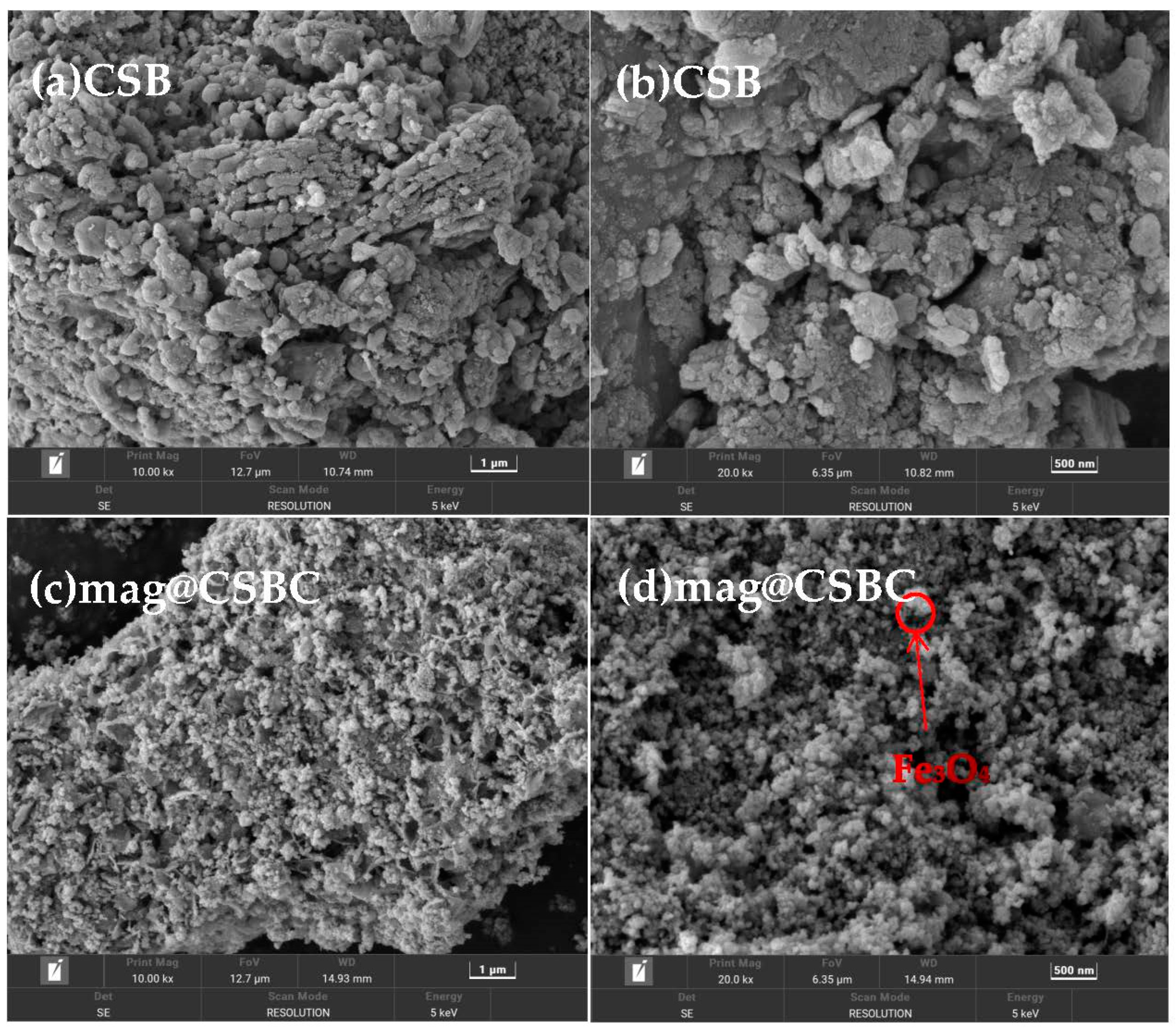
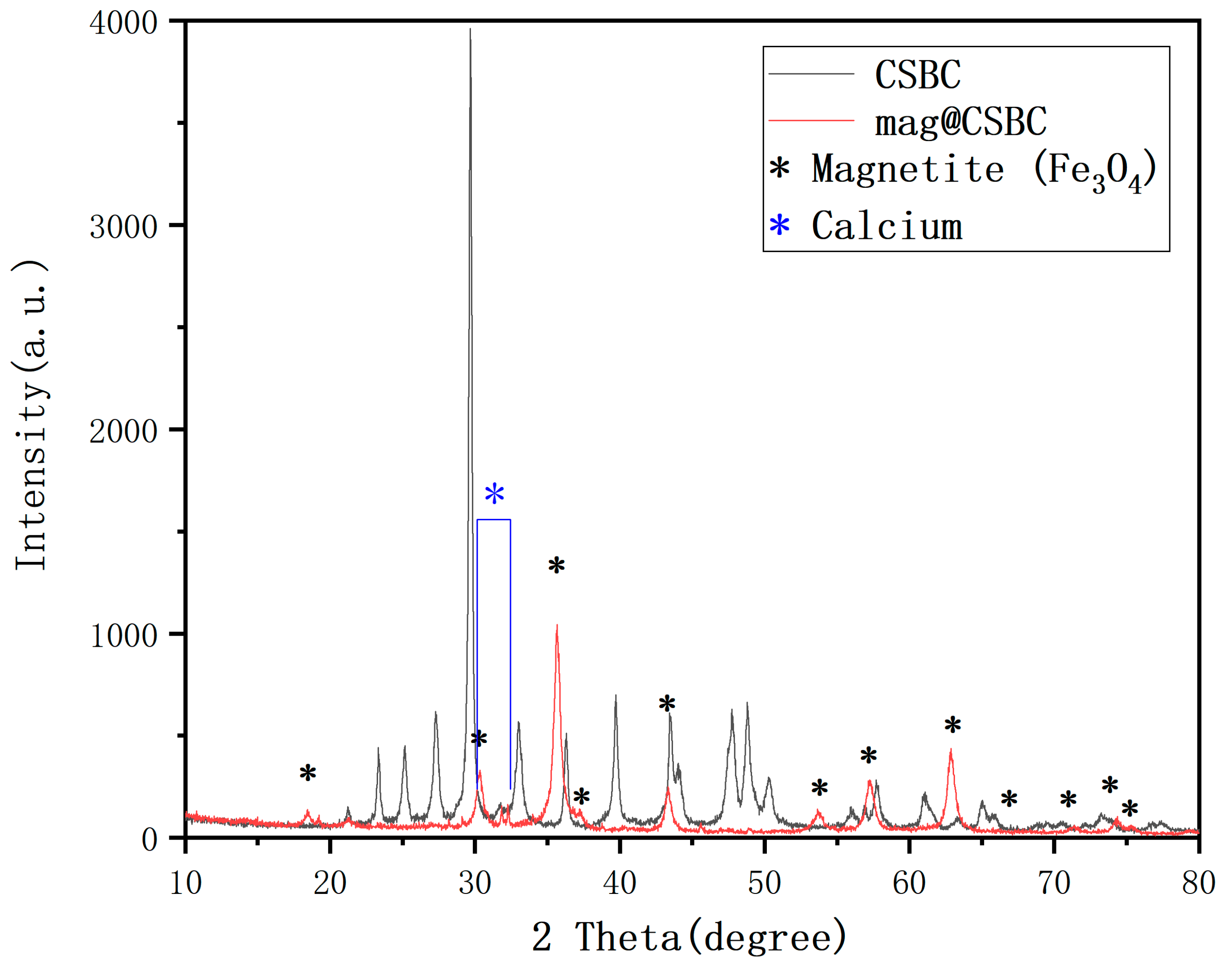
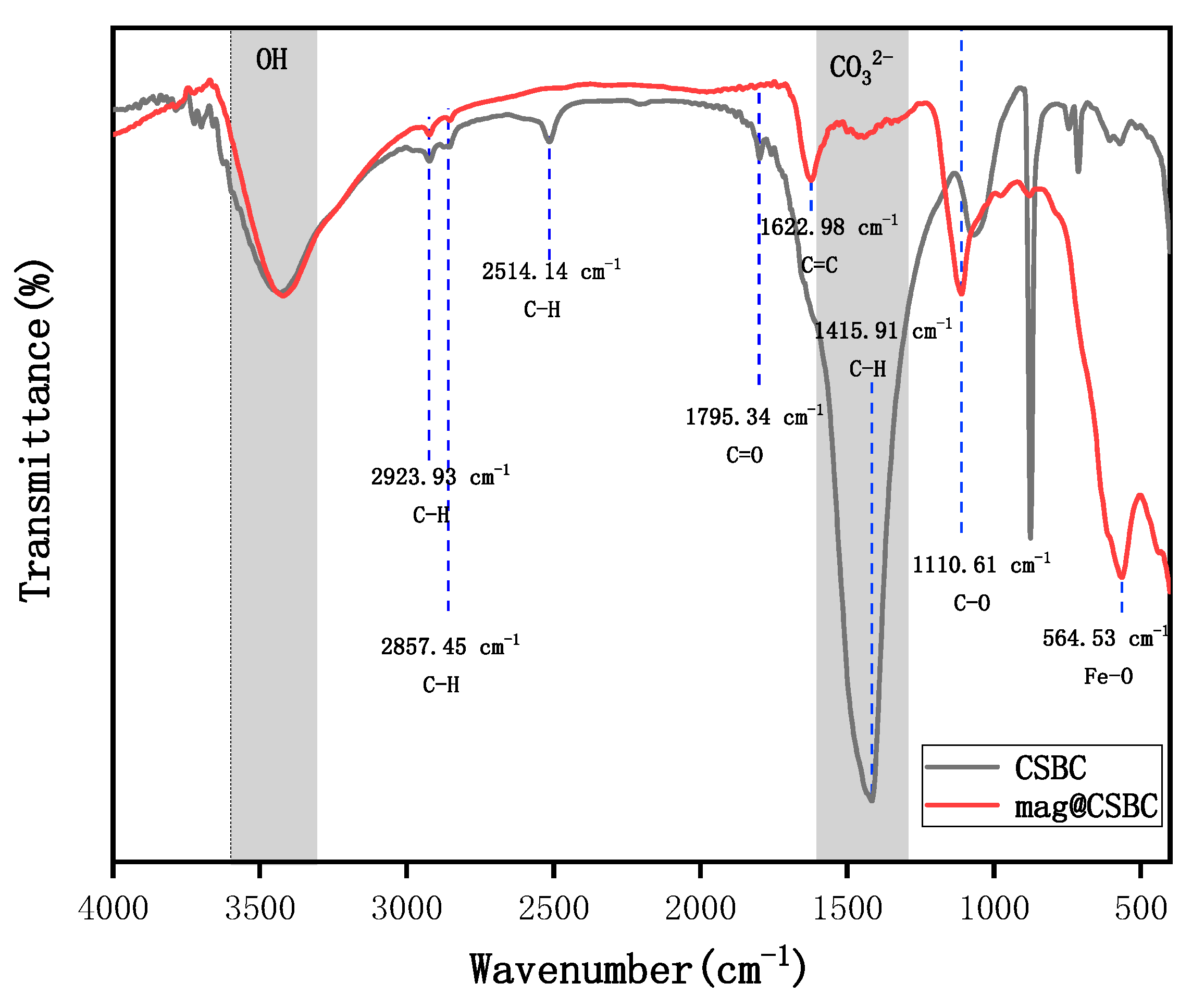
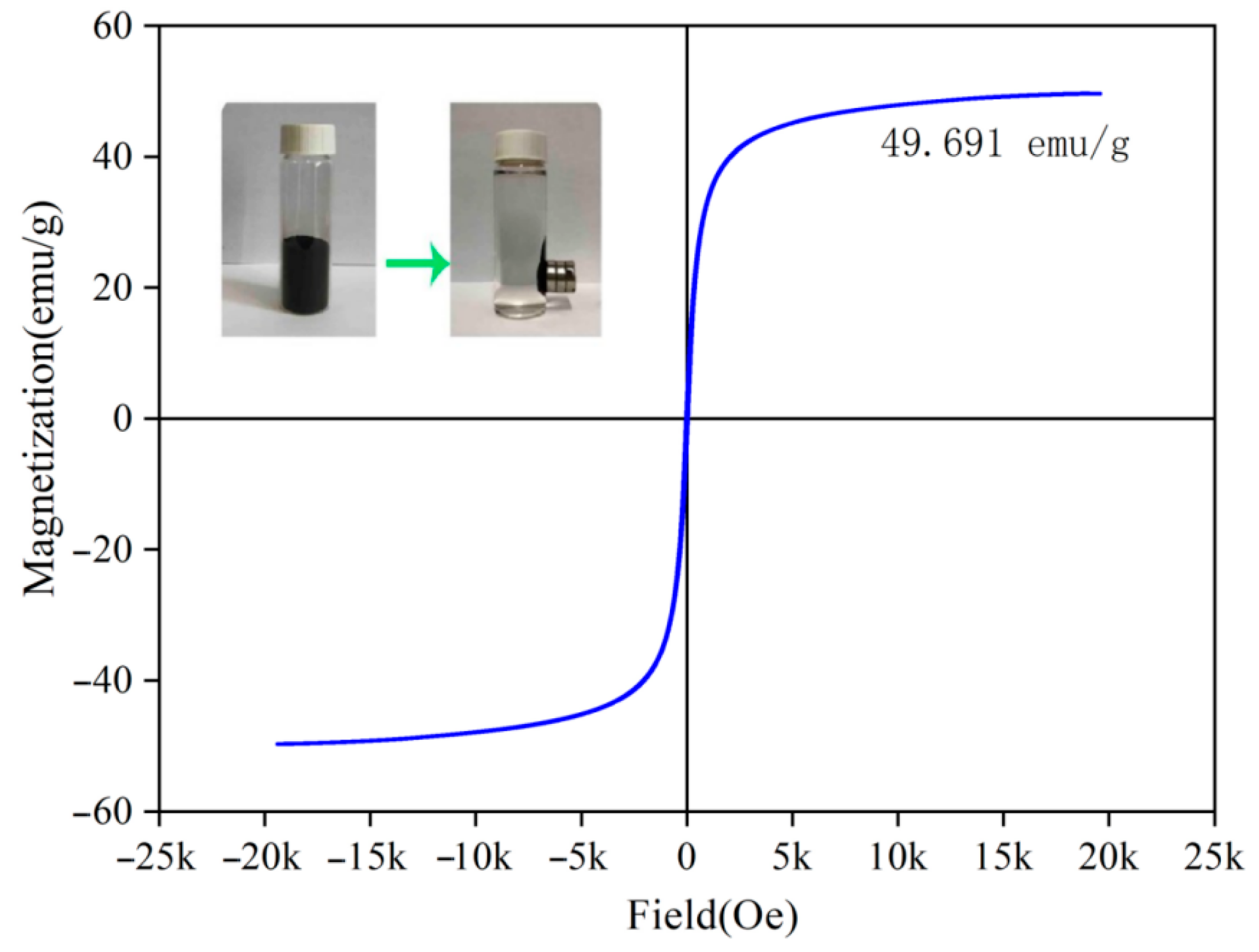
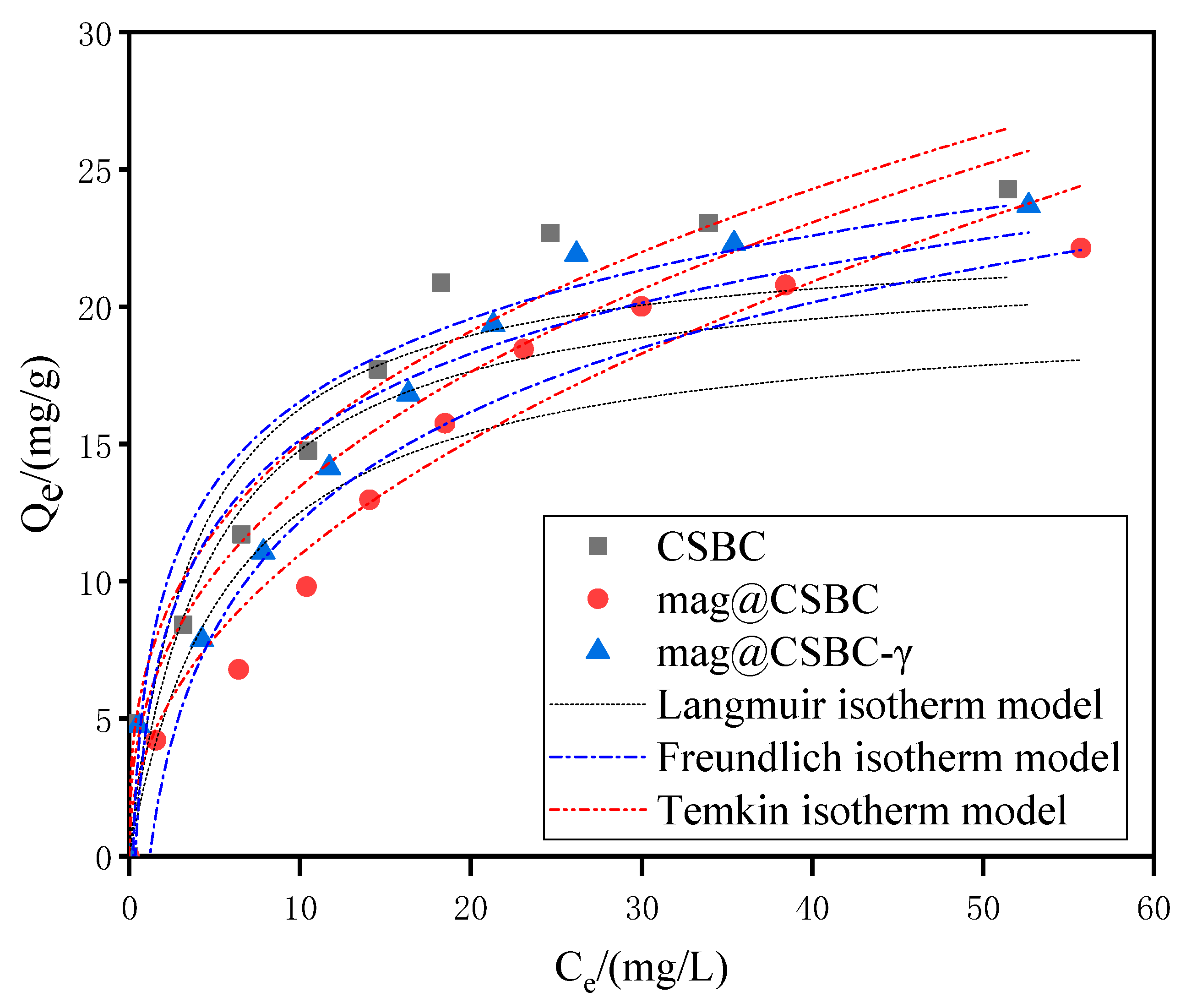


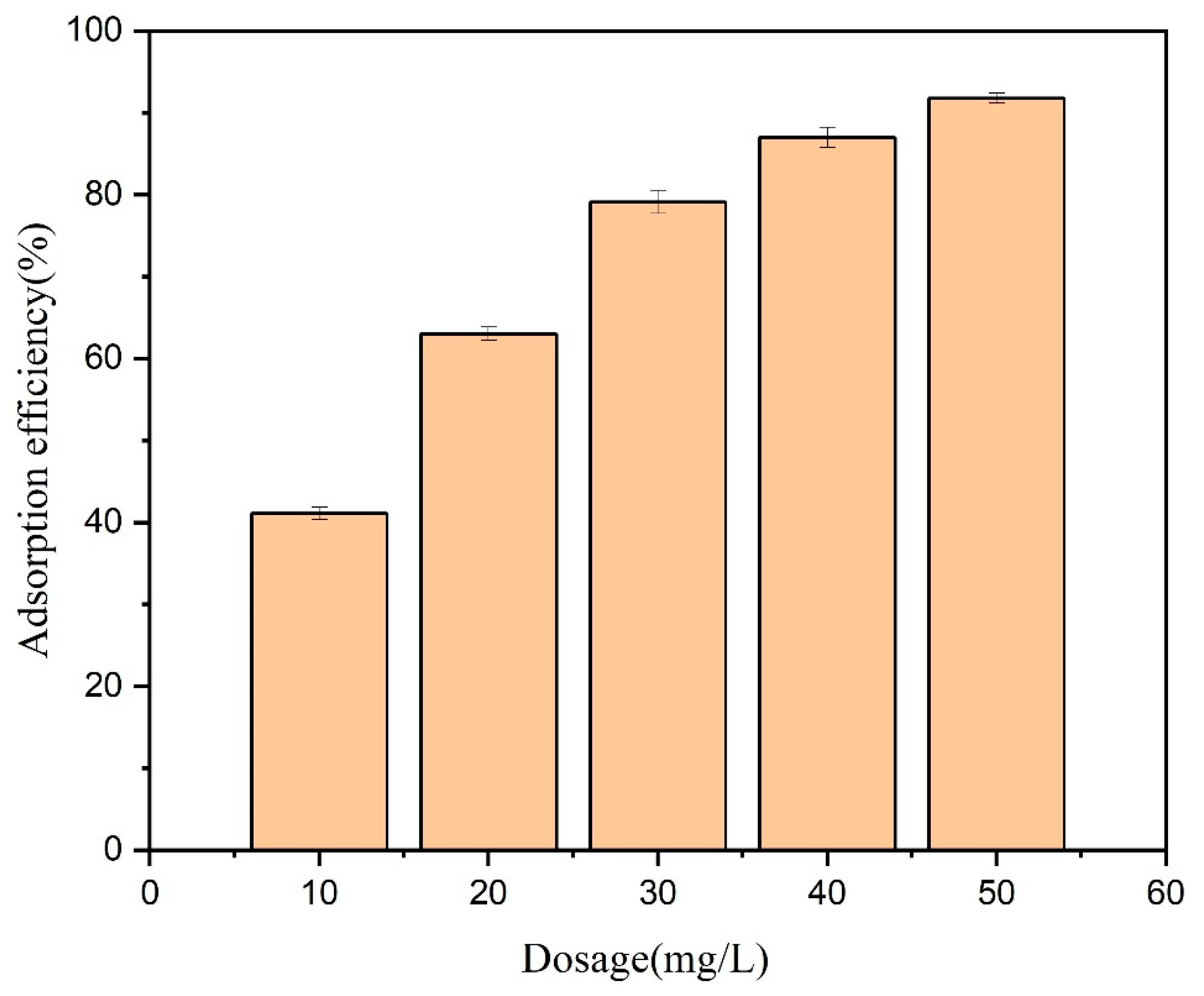
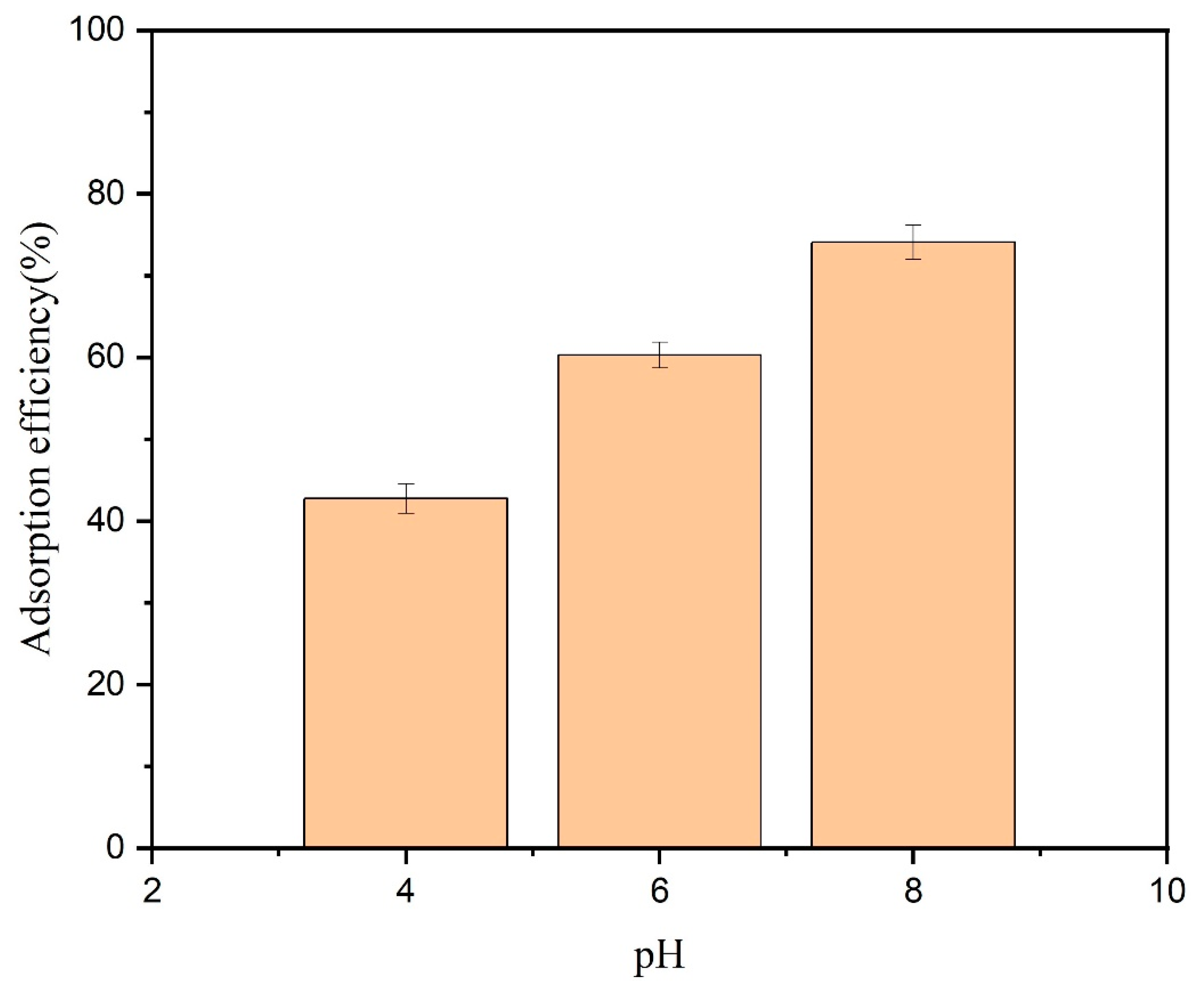
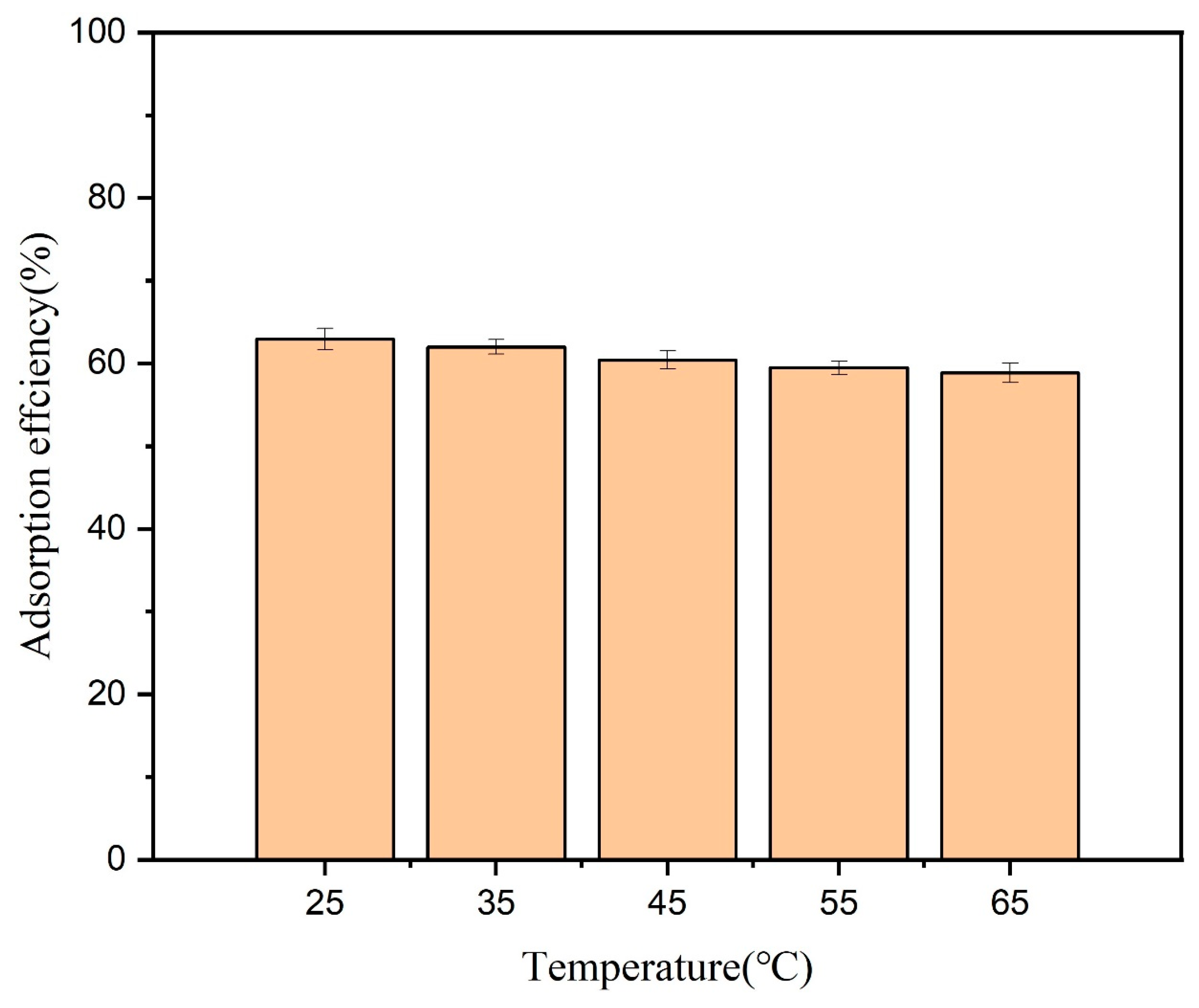
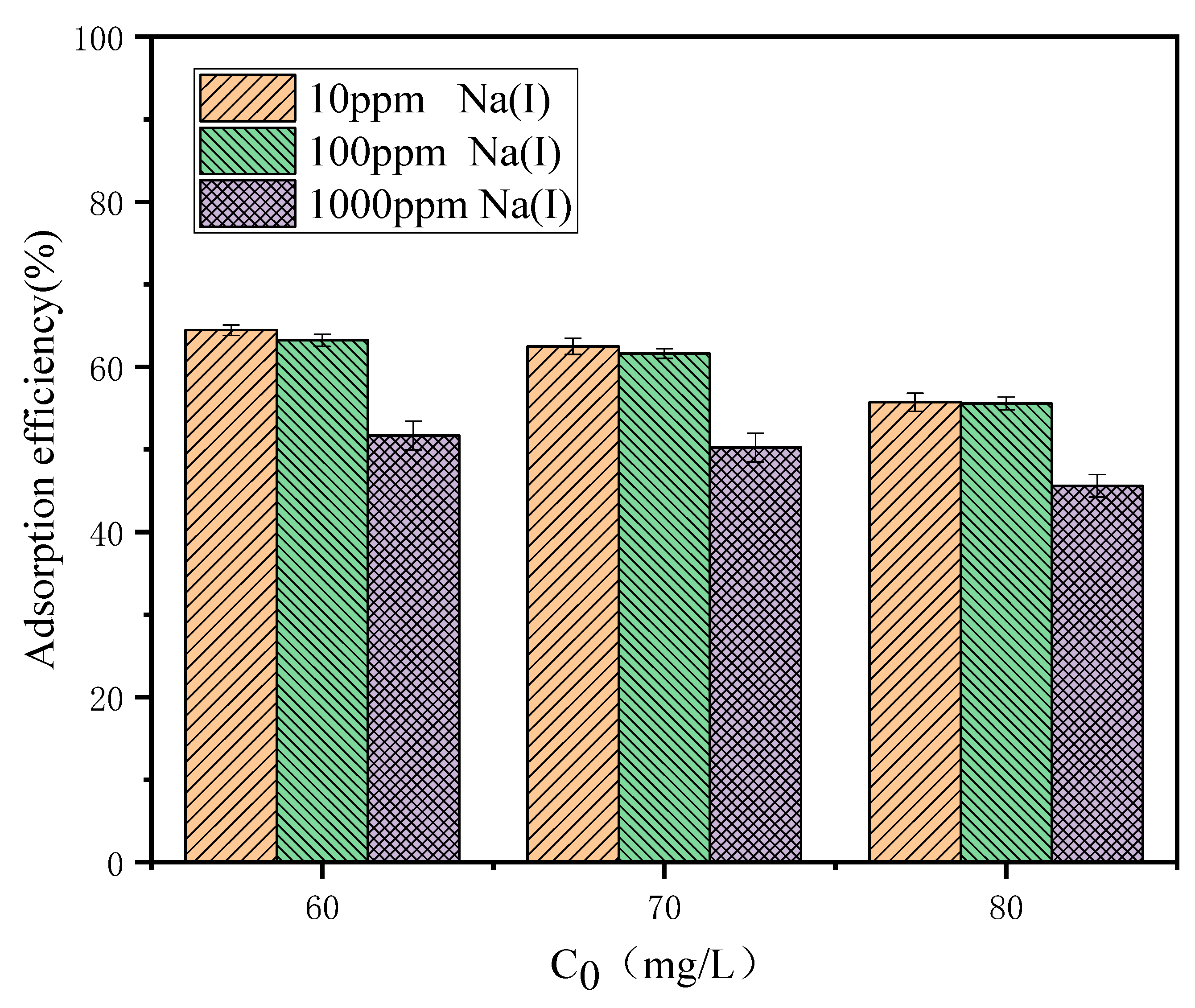
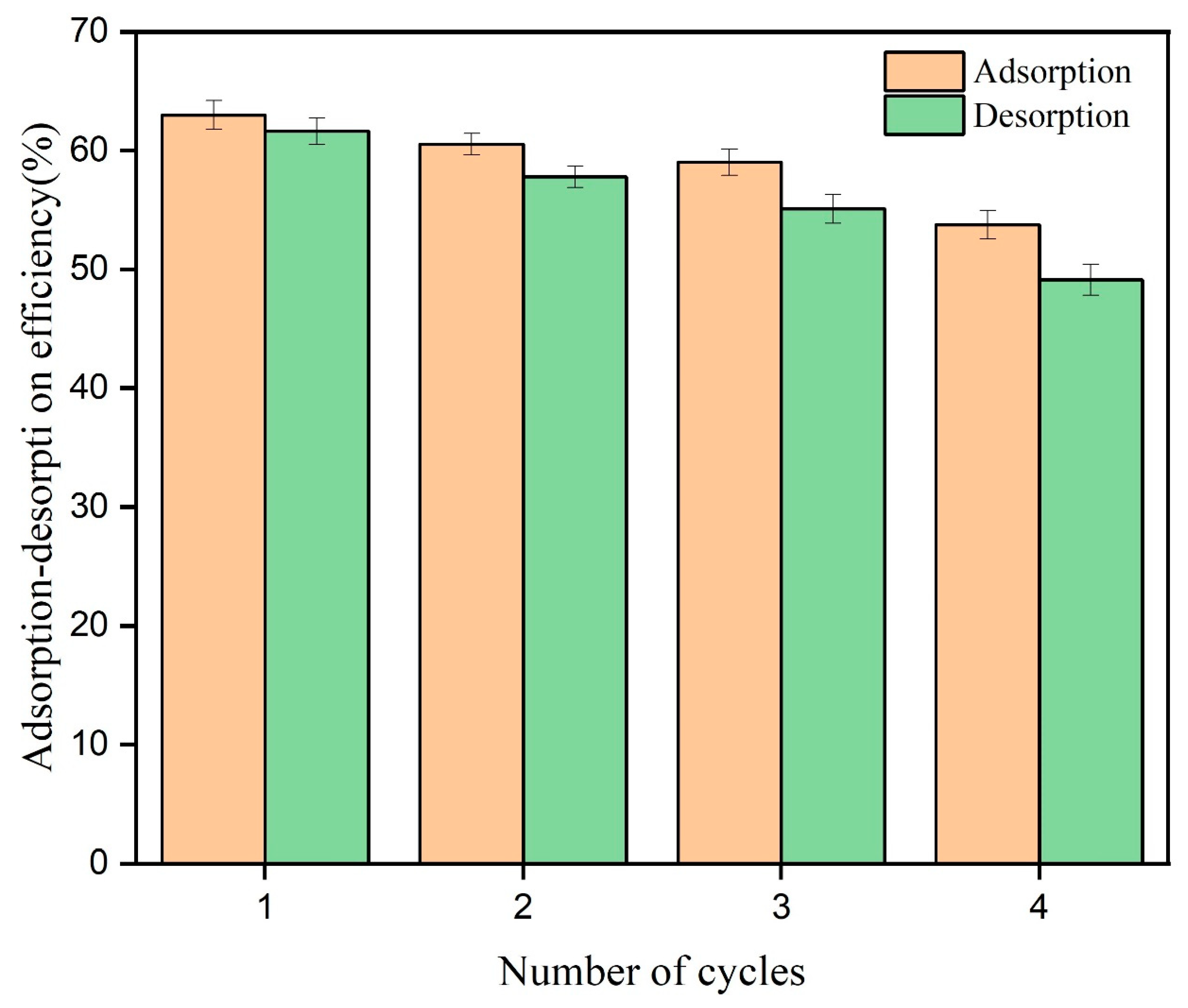
| Property | Proportion (CSBC/mag@CSBC) | Property | Proportion (CSBC/mag@CSBC) |
|---|---|---|---|
| Yield (%) | 54.53/67.13 | Atomic ratio O/C | 0.823/0.741 |
| C (%) | 18.7/21.22 | Atomic ratio H/C | 0.33/0.14 |
| N (%) | 0.91/0.77 | pH value | 10.63/9.23 |
| O (%) | 20.52/25.13 | BET surface area (m2/g) | 26.77/38.12 |
| H (%) | 0.52/0.41 | Pore volume (cm3/g) | 0.12/0.18 |
| S (%) | 2.94/1.32 | Average pore diameter (nm) | 22.86/14.41 |
| Fe (%) | 0/9.43 |
| Models | Parameters | CSBC | mag@CSBC | mag@CSBC-γ |
|---|---|---|---|---|
| Langmuir isotherm model | Qm (mg/g) | 22.670 | 20.006 | 21.902 |
| b (L/mg) | 0.255 | 0.167 | 0.207 | |
| r2 | 0.916 | 0.869 | 0.904 | |
| Freundlich isotherm model | Kf [(mg/g) (L/mg)1/n] | 6.771 | 3.761 | 5.498 |
| n | 2.889 | 2.151 | 2.573 | |
| r2 | 0.964 | 0.955 | 0.969 | |
| Temkin isotherms model | KT (L/g) | 4.450 | 2.773 | 0.831 |
| B (L/mg) | 10.037 | 10.488 | 13.243 | |
| r2 | 0.927 | 0.919 | 0.939 |
| Adsorbent | Qm (mg/g) | References |
|---|---|---|
| mag@CSBC-γ | 21.902 | This study |
| mag@banana peels biochar | 23.827 | [26] |
| carboxymethyl chitosan | 105.81 | [60] |
| Fe3O4@titanate fibers | 37.1 | [61] |
| Melamine-trimesic acid modified attapulgite | 26.21 | [62] |
| Paprika biochar | 0.02 | [25] |
| Hybrid membranes | 0.94 | [63] |
| coffee grounds | 69.013 | [28] |
| Models | Parameters | mag@CSBC | mag@CSBC-γ |
|---|---|---|---|
| Pseudo-first-order model | Qe (mg/g) | 20.835 | 23.473 |
| ka (min−1) | 0.145 | 0.138 | |
| r2 | 0.996 | 0.972 | |
| Pseudo-second-order model | Qe (mg/g) | 26.241 | 30.183 |
| kb (min−1) | 0.005 | 0.004 | |
| r2 | 0.983 | 0.952 |
| Irradiation Environment and Parameter | Adsorption Stage | |||
|---|---|---|---|---|
| Stage 1 | Stage 2 | Stage 3 | ||
| mag@CSBC | kd (mg/g∙min0.5) | 5.769 | 2.179 | 0.230 |
| C (mg/g) | −1.789 | 10.020 | 18.933 | |
| r2 | 0.847 | 0.944 | 0.984 | |
| mag@CSBC-γ | kd (mg/g∙min0.5) | 6.294 | 3.612 | 0.450 |
| C (mg/g) | −2.341 | 7.057 | 19.911 | |
| r2 | 0.885 | 0.834 | 0.840 | |
Disclaimer/Publisher’s Note: The statements, opinions and data contained in all publications are solely those of the individual author(s) and contributor(s) and not of MDPI and/or the editor(s). MDPI and/or the editor(s) disclaim responsibility for any injury to people or property resulting from any ideas, methods, instructions or products referred to in the content. |
© 2023 by the authors. Licensee MDPI, Basel, Switzerland. This article is an open access article distributed under the terms and conditions of the Creative Commons Attribution (CC BY) license (https://creativecommons.org/licenses/by/4.0/).
Share and Cite
Lu, W.; Feng, J.; Otero, M.; Liao, T.; Qiu, L. Removal of Sr(II) in Aqueous Solutions Using Magnetic Crayfish Shell Biochar. Separations 2023, 10, 310. https://doi.org/10.3390/separations10050310
Lu W, Feng J, Otero M, Liao T, Qiu L. Removal of Sr(II) in Aqueous Solutions Using Magnetic Crayfish Shell Biochar. Separations. 2023; 10(5):310. https://doi.org/10.3390/separations10050310
Chicago/Turabian StyleLu, Wenchao, Jundong Feng, Marta Otero, Tao Liao, and Liang Qiu. 2023. "Removal of Sr(II) in Aqueous Solutions Using Magnetic Crayfish Shell Biochar" Separations 10, no. 5: 310. https://doi.org/10.3390/separations10050310
APA StyleLu, W., Feng, J., Otero, M., Liao, T., & Qiu, L. (2023). Removal of Sr(II) in Aqueous Solutions Using Magnetic Crayfish Shell Biochar. Separations, 10(5), 310. https://doi.org/10.3390/separations10050310







